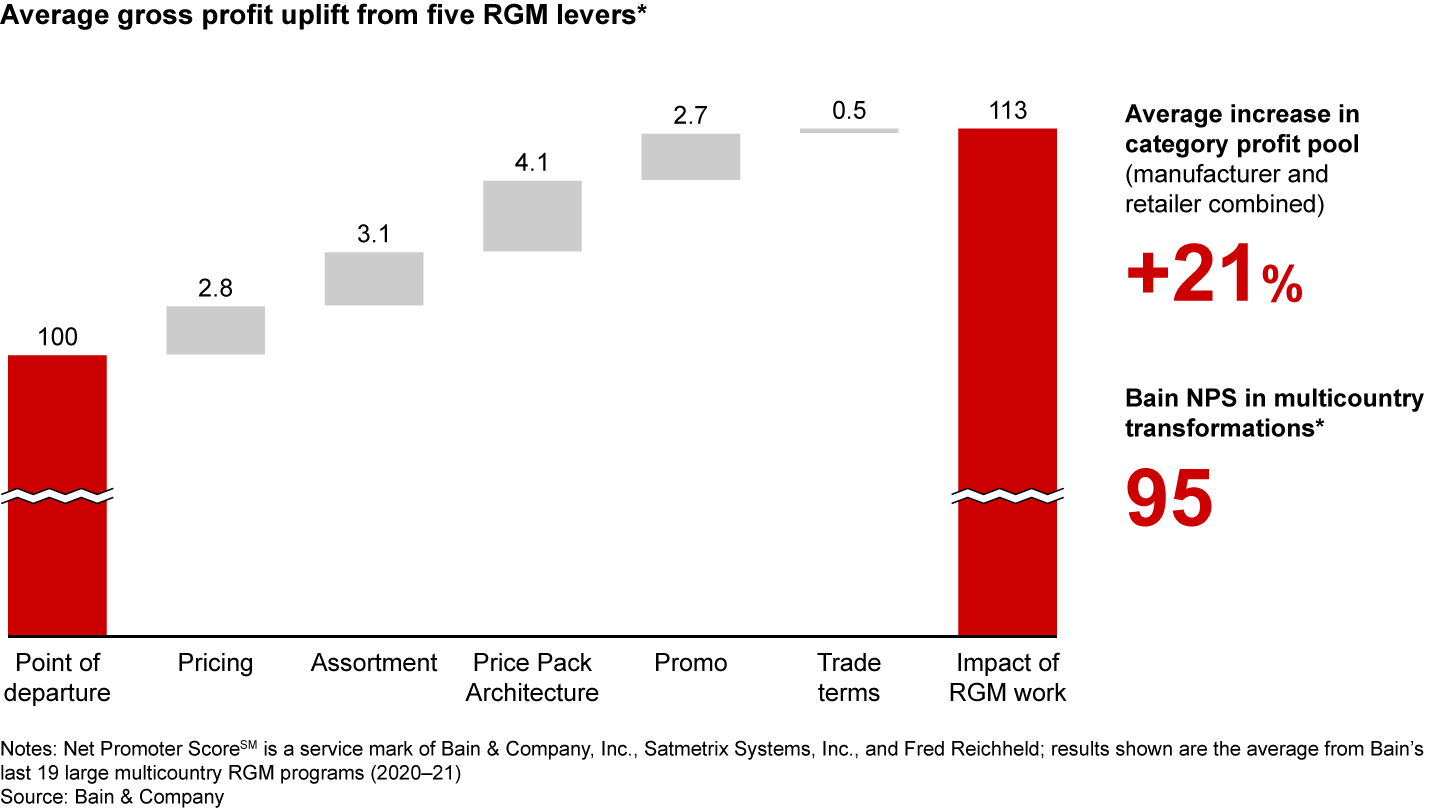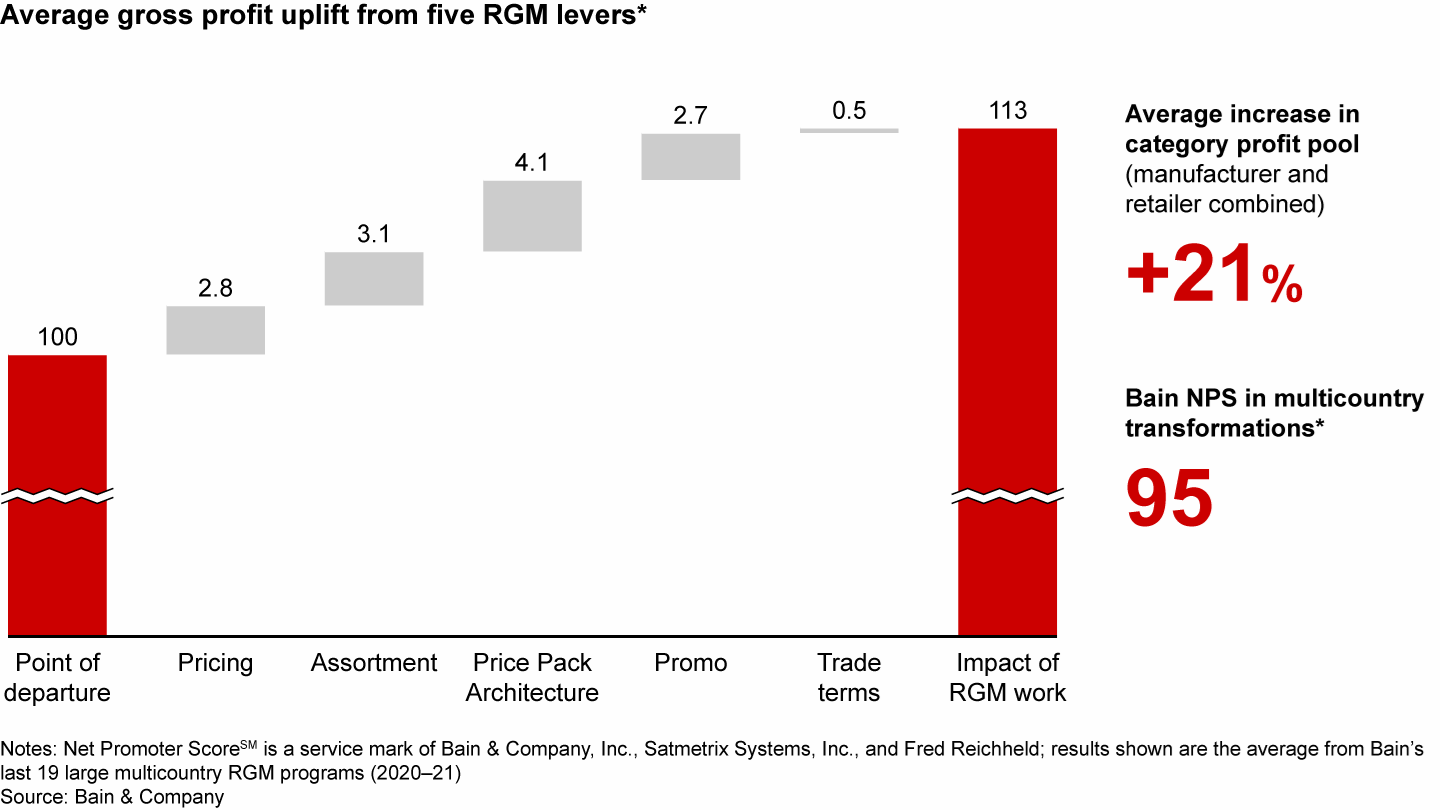Article
At a Glance
- With inflation surging, CP companies must act now to strengthen this vital value-creation muscle.
- Organizations need to define a clear role for RGM, aligning on the program’s ambition and how to measure its success.
- Our proven framework focuses on four imperatives: maximizing value for all stakeholders, building the right technological foundation, evolving your RGM operating model, and keeping a multiyear perspective.
With global inflation reaching heights not seen in decades, and strained manufacturers and retailers anticipating their toughest negotiations ever, consumer products companies are under immense pressure in 2022. Depending on the combination of category and geography, CP companies may see 10%–30% of their profit at risk.
The best available defense is to develop a rock-solid program for revenue growth management (RGM)—a unified plan that balances your decisions on pricing, assortment, price-pack architecture, promotions, and trade terms.
Chances are you already know your organization’s RGM program is inadequate. More than 80% of the CP chief executives we’ve spoken to are dissatisfied with their RGM results. This attitude prevails despite multiyear, resource-intensive efforts in this area. Our research shows that:
- Only 1 in 10 brands is able to simultaneously grow share, category leadership, and profit.
- About 50% of all promotional sales cannibalize nonpromotional sales, and 80% of promotional investment fails to contribute to category growth.
- About 70% of SKUs generate unneeded complexity and costs and deliver less than 5% of total category revenues.
- About 75% of RGM programs do not generate positive profit growth for both the retailer and the manufacturer.
Worst of all, we often see multimillion-dollar IT and AI investments result in complex, hard-to-build systems that fail to win widespread adoption. For example, we see programs where 50% of the program’s functionality isn't used, or as much as 70% of the solutions are deployed in only one market.
We believe that every CP organization needs to define a clear role for RGM—its ambition and an agreed-upon measurement of success—and design RGM programs around four bold imperatives:
- Adopt a trifecta approach that maximizes value for consumers, retailers, and manufacturers.
- Build the right technological foundational so your data and analytics can make critical insights available to the front line in a simple way.
- Substantially evolve the legacy commercial routines and RGM operating model to maximize adoption and pragmatism.
- Keep multiyear perspective, but achieve quick wins to build necessary confidence and momentum.
Revenue growth management: Solving the puzzle
Use a trifecta approach
Companies must gear their RGM programs to maximize the value created for consumers, retailers, and manufacturers. Too often, however, they focus only on their own needs. It's not enough to install a large and articulated RGM program that delivers great insights for a commercial team; such a tool needs to reveal value for every stakeholder, not just help your sales team know what to do to maximize their own profit.
Successful RGM programs are disciplined about meeting high standards for three must-have KPIs. The first is trade profit. Improvement of retailers’ economics is a must for any RGM initiative that wants to move from PowerPoint to successful negotiation and execution. Next is consumer value; RGM programs should focus investments on initiatives that ensure incremental household penetration through prices that are adapted to occasions and consumer needs. Finally, companies should strive for 360-degree manufacturer ROI. That means scrutinizing initiatives to make sure they also consider an investment’s impact on noncommercial assets like supply chain and procurement.
All too often, RGM programs deliver too much granular detail, contributing to sales team fatigue. In such cases, fewer and fewer insights are converted into negotiated agreements with customers. As results decline, skepticism grows about the value of an RGM approach, and eventually these valuable tools are abandoned.
Revenue growth management delivers results


Build the right technological foundation
Structure your data and analytics capabilities to make critical insights available to the frontline in a simple way. Your sales team won’t trust a “black box” solution. Plenty of CP companies have launched large-scale system upgrades, only to find that the their investment results in a level of complexity that limits adoption.
Successful use of technology and data in RGM programs usually demonstrates a few key characteristics. First, a unified data model that allows companies to collect and combine all of their data in one place: master data, shopper data, in-store activation, sell-in, sell-out, financials, and also environmental factors (to account for seasonality). Next, an "end-user-back” approach. This means designing solutions to save valuable time for the commercial front line (to stimulate adoption). These solutions are fully connected to existing commercial processes (to avoid disruption) and feature insights that can be used selectively during customer negotiations. Finally, your own people need to be involved with leading tech infrastructure development. Leaders need to engage with innovative tech players to develop a bespoke product. Front line commercial teams, supported by IT teams, should launch a minimum viable solution (MVS) quickly in test markets, then roll out a more complete solution more broadly to encourage adoption.
Substantially evolve the legacy commercial routines and RGM operating model
Companies that get RGM right pay attention to the details that maximize adoption and pragmatism. Companies that build a fully-fledged RGM team from scratch risk seeing those teams become known for producing thousands of PowerPoint pages for internal consumption that were rarely used by the front line.
The way RGM practices are embedded in a company’s operations matters greatly. Programs should strive for a customer GM mindset, where multifunctional teams serving a client share the ultimate goal of growing the joint profit pool of the retailer and manufacturer. Team leaders need to bring their customers a plan that is not only shaped by RGM insights, but also realistic and flexible. This means building on existing commercial routines. Leaders should identify the few high-potential spots where they can inject RGM discipline into existing commercial processes. This limits disruption and maximizes adoption much more than a complete redesign of commercial processes. Next comes upgrading performance management systems with KPIs that ensure RGM is woven into customer planning and new investment approvals.
Keep multiyear perspective
Establishing a winning RGM program requires taking a long view, but achieving quick wins is important for building confidence and momentum among the sales force. Companies can maintain excellent discipline in their RGM transformations, but when the lion’s share of executives’ attention is diverted toward dealing with bumps in the road, programs can quickly fall short of their goals.
The best RGM transformations are led by teams that clearly spell out the definition of RGM success and set several nonnegotiable goals to use as the lighthouse for any decision. They then install an incentive system to reward those who plan and execute the actions related to the RGM goals. Teams can aim to achieve up to 20% or more of their expected RGM upside within a year of adoption, doing whatever it takes to generate early momentum. But they should also plan for multiyear results. Within the first six months of a transformation, teams should develop a three-year vision of full RGM implementation and describe what the journey means in relation to retailers. This should be followed by continuous improvement; companies should refresh their RGM plans and initiatives every six months and annually assess their evolving capabilities against precodified maturity levels.
A complex equation, but not an impossible one
Even in stellar economies, RGM is a complicated business. In today’s environment, it’s harder than ever for CP companies to protect their profit margins, but with the right approach, there’s a lot you can do.
We have proven success in helping CP leaders master the elements of RGM in a way that gets sustainable results. Our global network of 50+ partners and managers are complemented by experienced RGM practitioners who have designed, built, and implemented pragmatic CP- specific RGM solutions around the world.
Let us show you what can be done, starting with our proprietary maturity index, which measures your RGM capabilities based on more than 200 benchmarks. Whether your company sees RGM as a new frontier or a stubborn obstacle, we’ll show you exactly where to invest for lasting improvement.